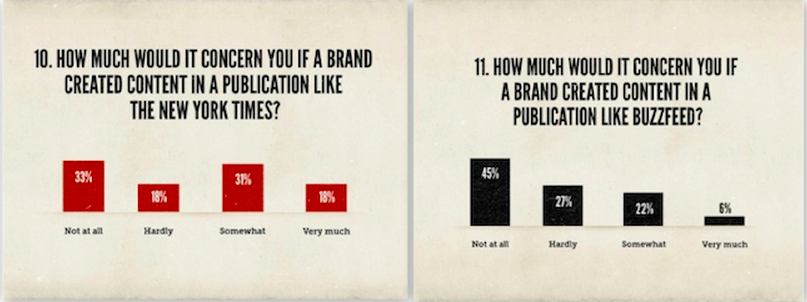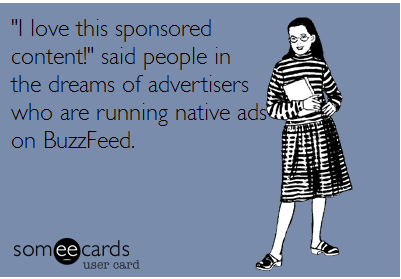By: Alexander Cano
@shaggycano Twitter & Instagram

What: “Native advertising is a form of online advertising that matches the form and function of the platform on which it appears.”
Where: “For example, an article written by an advertiser to promote their product, but using the same form as an article written by the editorial staff.” (Wikipedia)
Why?: Advertisers know that the most powerful tool available to their clients is positive word of mouth. Native advertisements disguise themselves as either positive reinforcement of a brand or belief, or on the flipside, negative reinforcement of another brand or belief. Native advertising is designed to be as seamless as possible so that the reader hardly recognizes that the content they’re reading was paid for and not the result of objective journalism.
Issues at stake: The most problematic thing about native advertising is that it seems to be inherently misleading. FTC Regulations have always upheld that sponsored content must always be labeled- clearly – as such and be it also must be able to identified as sponsored content by any viewer. Going off WOMMA’S Honesty ROI- the idea of native advertising violates the Honesty of Relationships, Opinions, and Identity. Since almost every media curator labels their sponsored content in different ways, its next to impossible to assume that consumers area all always aware of the intentions of the content they are absorbing. Sponsored blog post writers never reveal that they are professional copywriters or people paid to have a specific opinion, and that is troubling. There’s a large issue of integrity at stake here. People become regular consumers of media that they trust, and assume their favorite publications will keep working with the same integrity that they always have. A publication like the New York Times exists under the pretense that every single word in their paper is truthful and objective (except for editorials of course). Even in an editorial that takes fully supports a brand and has nothing but positive things to say about them can be trusted because there’s no conflict of interest: the writer has nothing to gain financially by sharing their opinions, and it is seen as more authentic.
Regardless, native ads platforms / Storygize have proven to be an effective tool in online advertising for many businesses. It can transform the way businesses connect with customers and, if done in the right way, can be done well whilst remaining ethical.
 There seems to be a correlation here between how respected a publication is and how much native advertising would be problematic. So does native advertising corrode trust? If that’s what the general opinion points to, it must then be inherently “wrong” or misleading i.e. unethical. What do you think?
There seems to be a correlation here between how respected a publication is and how much native advertising would be problematic. So does native advertising corrode trust? If that’s what the general opinion points to, it must then be inherently “wrong” or misleading i.e. unethical. What do you think?



Alex,
I think you bring up very interesting ethical questions concerning “native advertising.” It is interesting to see that there are definitely benefits to native advertising such as positive reinforcement of a brand and natural content on a random site. BUT, there are a lot of downfalls one of which being misleading information. To not know that content is being written by that brand or company is troubling. This is the same issue that has plagued Ann Taylor and Victoria Secret as reviewers are asked to review free materials. What is the proper method of getting reviews without providing the product? I think something as simple as information on why a reviewer may need a product and where to get that product is a great place to start. Alex, great thoughts on the downfall of native advertising!
-Drew Forrest
I would definitely agree that native advertising is unethical. I don’t really see any way in which someone could argue against that. I took a class on magazine industry and strategies last term, and we had a whole unit on advertising. We studied several different media kits, and most had policies which required that advertisements not use any of the same fonts or style that the publication used, for that very same reason. However, some publications actually have an advertorial department in house, where they hire copywriters to produce content that purposefully looks like their own content. There’s actually an episode of the show Girls in which the main character interviews a celebrity for an advertorial, and she blatantly tells the celebrity to just “make something up” because she hadn’t actually used the product that the advertorial was trying to sell. Companies will apparently pay tons of money for this type of advertising, but it’s horribly unethical. I’m not quite sure how they still get away with this.
I think the conversation we had about transparency and disclosure in social media and advertising this week brought up a lot of interesting issues. I don’t think there is necessarily a definite line for disclosure as long as you are following ftc regulations and are not trying to portray a piece of work as something its not. I don’t think that businesses should have to go above and beyond to mark up their native advertising with disclaimers and warnings about perspective. As long as they disclose that it was payed for I think it is up to the consumer to take it with a grain of salt and most can use their common sense. I thought there were interesting points about how to go about telling people who is running a certain Twitter account and how far you have to go to show followers that it is or is not you Twitting at the moment. I think it is about setting expectations in the bio or in some way but not being obnoxious about the logistics of who’s posting what.
Alex,
“Native Advertising” is interesting because there is a fine line between advertisers trying to speak the language of their audiences to foster a deeper connection, versus misleading their target audience to believe they are someone that they are not. I believe this distinction differs on a brand to brand basis. It is important that ALL brands disclose who they are while speaking to their audience. However, I also believe as the audience continues to utilize social media and other online platforms they will become more literate while deciphering where the sources are coming from. It will be interesting to see how changing technologies modify these boundaries, and how brands can navigate online spaces in an ethical manner.
-Katie McGuigan
@knmcguigan
I think the concept of native advertising interesting because the content is coming straight from the advertiser themselves in order to promote their product. Personally, if I read an article about a product and I knew it was written by the advertiser in order create more revenue, I would think it was unethical. Disclosure and transparency is extremely important in native advertising otherwise there will be a serious ethical conflict. If people are trusting their specified media outlets and are unaware that the articles they are reading are biased because of native advertising, the publication’s integrity will ultimately be sacrificed.
Alex, the layout of your blog post was straight to the point, making your post not only a breeze to read, but highly informative as well. I especially appreciated the infographic you chose to include. I think you brought up some great points on the ethics surrounding native advertising. More often than not, the native advertising I have stumbled upon isn’t clearly labeled as sponsored content, at least not by first glance. I definitely agree that sponsored content in the form of articles tends to seem the most unauthentic. Whereas sponsored content on social media sites like Twitter and Instagram tends to just be bothersome.